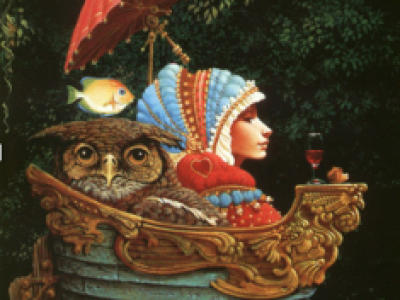By Holly Mancuso, Dramaturg The Count of Monte Cristo is a strikingly visual production, from versatile moving set pieces to brightly colored costumes. To help create the settings and emotions of the play, as well as to bring audience members into the story, there is near constant use of projected images and designs. Daniel Fine, a media designer and recent MFA graduate in interdisciplinary digital media from Arizona State University, has been recruited to craft and create these projections for Monte Cristo. Projections in history Projections are coming back into style in theatre, and have gained recognition as a distinct field, aren't new. In fact, they have been in use since the early 1900s. Erwin Piscator, a German theatre director and producer, worked heavily with projections and film techniques in the 1920s. To learn more about projections in theatre, see this post from American Theatre magazine in December 2011. [caption id="attachment_3412" align="aligncenter" width="390"]

A stage design by Piscator using projections for a 1928 stage play.[/caption] Projections in The Count of Monte Cristo When asked about his role in the production, Daniel responds that he is "the projection designer. In the business in general, people define themselves differently-projection designer, video designer, media designer. It depends on your school of thought and what you're doing". Daniel came on the job in August, and has since worked with the production team to make the show larger than life. The Projection Process To create the unique backgrounds for the show, Kristi Harmon was hired as an artist to create line drawings and illustrations of the scenes. When Daniel came in the project, he gave Kristi research images related to the director's concept. She has since drawn illustrations by hand and imported them into Photoshop, where they can be separated into different layers. Daniel, with the help of his two student assistants Bradlee Hager and Justin Hemsley, took those layers to work on and clean up in Photoshop. Each file was then imported into After Effects (an Adobe program for motion graphics) to animate them. Finally, stock and custom-made footage were added in to accent and go over all the other work. With the the help of Marianne Ohran as a programmer for the Green Hippo (a media server that runs all the projections and movies, including the four projectors used in the show), they all collaborated and combined their talents to create the fluid visual projections seen in the show. [caption id="attachment_3416" align="aligncenter" width="403"]

A Green Hippo hippotizer, a media server used in the show.[/caption] Taking it to the stage Even after all that work to create images, the job isn't over. "We're mapping, basically", Daniel explained. "In this case it's a little easier because everything's basically a rectangle. We're mapping onto three towers...that are always in different places, [another moving set piece], a banner, the front grand curtain, a scrim, and a rear projection screen. So we're working with eight surfaces, and that becomes time consuming....[It's not like] turning on a TV. You have to map to each of those pieces." Educational Aspect and Other Works Because of his almost 20 years as an educator and teacher, BYU has been fortunate enough to host Daniel in a series of workshops and master classes in the recent months. This has been a great opportunity for students and faculty to learn more about his work in design and systems and how we can incorporate it in our theatre practices. [caption id="attachment_3417" align="aligncenter" width="419"]

A picture from one of Daniel's previous works, A Brief Anniversary of Time, which incorporated media design with live performance.[/caption] Daniel doesn't just work with projections, but also has experience with music, dance, film, art installations, and other areas of media design. To learn more about Daniel's diverse range of work, visit his website at danielfine.net.


